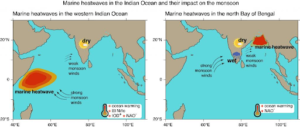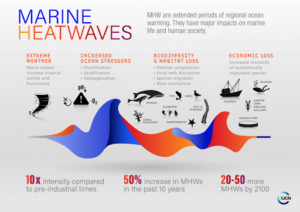In news– A new study has found that marine heatwaves have been on the rise in the waters around India and are impacting the Indian monsoon.
Key findings–
- An underwater survey showed that 85% of the corals in the Gulf of Mannar near the Tamil Nadu coast got bleached after the marine heatwave in May 2020.
- The Western Indian Ocean region experienced the largest increase in marine heatwaves at a rate of about 1.5 events per decade, followed by the north Bay of Bengal at a rate of 0.5 events per decade.
- From 1982 to 2018, the Western Indian Ocean had a total of 66 events, while the Bay of Bengal had 94 events.
- The marine heatwaves in the Western Indian Ocean and the Bay of Bengal increased drying conditions over the central Indian subcontinent.
- Correspondingly, there is a significant increase in the rainfall over south peninsular India in response to the heatwaves in the north Bay of Bengal.
- These changes are in response to the modulation of the monsoon winds by the heatwaves.
- This is the first time that a study has demonstrated a close link between marine heatwaves and atmospheric circulation and rainfall.
- Climate model projections suggest further warming of the Indian Ocean in the future, which will very likely intensify the marine heatwaves and their impact on the monsoon rainfall.
- According to the National Oceanic and Atmospheric Administration of the United States, around 90 per cent of the warming caused by greenhouse gas emissions is absorbed by the oceans.
- The increase in marine heat waves was due to rapid warming in the Indian Ocean and strong El Nino events.
- This study was conducted by researchers and scientists from the Indian Institute of Tropical Meteorology, Pune, Kerala Agriculture University and Cochin University of Science and Technology.

What are marine heatwaves (MHW)?
- Marine heatwaves are periods of extremely high temperatures in the ocean.
- These events are linked to coral bleaching, seagrass destruction, and loss of kelp forests, affecting the fisheries sector adversely.
- Such heat waves are caused by an increase in the heat content of oceans, especially in the upper layers.
- Worldwide, they are one of the major results of human-induced global warming.
- Marine heatwaves are also associated with severe biodiversity changes such as sea star wasting disease, toxic algal blooms, and mass mortality of benthic communities.
- During an MHW, the average temperatures of the ocean surface (up to a depth of 300 feet) goes 5-7 degrees Celsius above normal.
- MHWs can cause extreme weather events such as tropical storms and hurricanes, and disrupt the water cycle; making floods, droughts and wildfires on land more likely.
- MHWs have been associated with the mass mortality of marine invertebrates, and may force species to change behavior in a way that puts wildlife at increased risk of harm. E.g. MHWs have been linked to whale entanglements in fishing gear, for example.

















